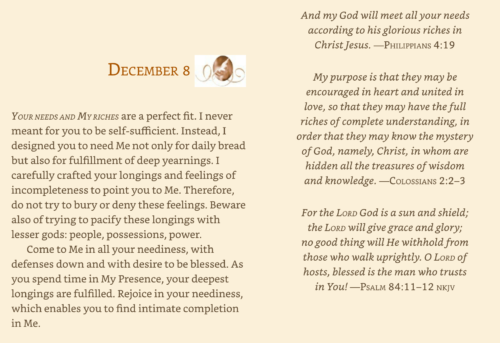The Christ Mystery
Richard writes about how the coming of Christ is far more than the birth of a baby. The Christ Mystery is nothing less than a cosmic hope for history:
The Second Coming of Christ that history is waiting for is not the same as the baby Jesus or even the historical Jesus. The historical Jesus was one man, and Christ is not his last name. The Christ includes the whole sweep of creation and history joined with him—and us too. We call this the Cosmic Christ. We ourselves are members of the Body of Christ and the Cosmic Christ, even though we are not the historical Jesus. So we very rightly believe in “Jesus Christ,” and both words are essential.
The celebration of Christmas is not a sentimental waiting for a baby to be born, but much more an asking for history to be born! (see Romans 8:20–23). Any spirituality that makes too much of the baby Jesus is perhaps not yet ready for real life. God clearly wants friends, partners, and images, if we are to believe the biblical texts. God, it seems, wants mature religion and a free response from us. God loves us as partners, with mutual give and take, and we eventually become the God that we love.
All of us take part in the evolving, universe-spanning Christ Mystery. Jesus is a map for the time-bound and personal level of life, and Christ is the blueprint for all time and space and life itself. Both reveal the universal pattern of self-emptying and infilling (Christ) and death and resurrection (Jesus), which is the process we have called “holiness,” “salvation,” or just “growth,” at different times in our history. For Christians, this universal pattern perfectly mimics the inner life of the Trinity in Christian theology, which is our template for how reality unfolds, since all things are created “in the image and likeness” of God (Genesis 1:26–27).
The power of the biblical proclamation is that it clearly invites us into “cooperation” (Romans 8:28), free “participation” (Philippians 3:10), and the love of free and mature persons in God (Ephesians 4:13). We can apparently trust ourselves to grow because God has done it first and foremost. The Christ we are asking for and waiting for includes our own full birth and the further birth of history and creation. Now we can say “Come, Christ Jesus” with a whole new understanding and a deliberate passion!
Franciscan theologian and scientist Ilia Delio affirms the intrinsic hope and loving responsibility of Christian faith in an evolutionary universe:
We must suffer through to something higher, something more unified, more conscious, more being in love. Hope must be born over and over again, for where there is love, there is hope. Christian life is birthing love into greater unity; it is our contribution to a universe in evolution. We point the way to something more than ourselves, something up ahead that we are now participating in, where heaven and earth will be renewed (Revelation 21). [1]

Cosmic Hope
Richard’s love for the Trinity finds inspiration from the Franciscan mystical scholar St. Bonaventure (c. 1217–1274), who viewed all reality as coming from, participating with, and returning to God. Such a cosmic vision is mystical hope at its best!
Bonaventure’s vision is positive, mystic, cosmic, intimately relational, and largely concerned with cleansing the lens of our perception and our intention so we can see and enjoy fully. He shows little interest in a reward/punishment frame for history.
He starts very simply: “For [none] can have understanding unless [they] consider where things come from, how they are led back to their end, and how God shines forth in them.” [1] For Bonaventure, the perfection of God and God’s creation is quite simply a full circle, and to be whole the circle must and will complete itself. He knows that Alpha and Omega are finally the same, and the key holding it all together in unity is the “Christ Mystery,” or the essential unity of matter and spirit, humanity and divinity.
In Bonaventure’s world, the frame of reality was still big, hopeful, and positive. He was profoundly Trinitarian, where the love always and forever flows in one positive and forward direction. That was both his starting point and his ending point. Most of Christian history has not been Trinitarian except in name, I am sad to report. It has largely been a worship of a Jesus who was extracted from the Trinity—and thus Jesus apart from the eternal Christ, who then became more a harsh judge of humanity than a shining exemplar of humanity “holding all things in unity” (see Colossians 1:17–20).
Today the Catholic Tradition celebrates the feast of the “Immaculate Conception” of Mary, who is the feminine archetype of a human woman carrying such wholeness from the very beginning of her life. This is esoteric for many, but it is really quite profound in its declaration!
God, for Bonaventure, is not an offended monarch on a throne throwing down thunderbolts, but a “fountain fullness” that flows, overflows, and fills all things in one exclusively positive direction. Reality is thus in process, participatory; it is love itself. God as Trinitarian Flow is the blueprint and pattern for all relationships and thus all of creation, which we now know from contemporary science is exactly the case.
I regret to say that there has been a massive loss of hope in Western history, a hope still so grandly evident in Bonaventure in the 13th century. His God was so much bigger and more glorious than someone to be afraid of, or the one who punished bad guys—because his cosmos was itself huge, benevolent, and coherent. Did his big God beget an equally big and generous cosmos? Or did his big cosmos imply a very big God? You can start on either side. For many today, awe before the universe leads them to reverence whoever created this infinity of Mystery and Beauty.
